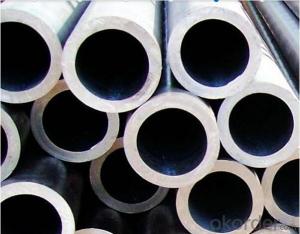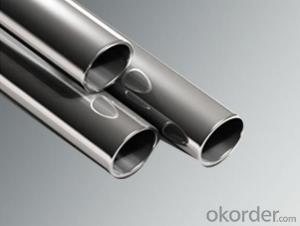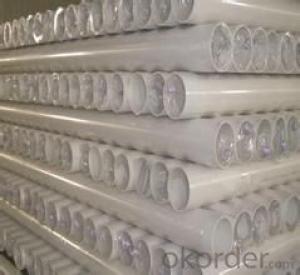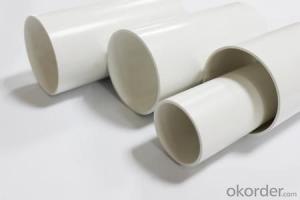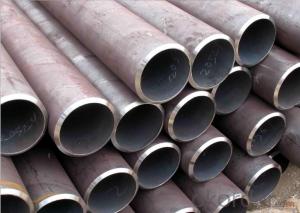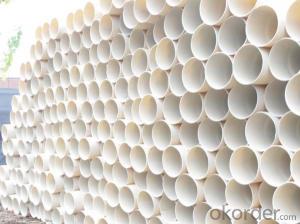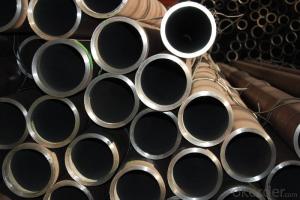astm a106 gr.b sch40/sch80/sch120/schxxs steel tube & seamless pipe for structure/construction
- Loading Port:
- Shanghai
- Payment Terms:
- TT OR LC
- Min Order Qty:
- 25 m.t.
- Supply Capability:
- 5000 m.t./month
OKorder Service Pledge
OKorder Financial Service
You Might Also Like
Specifications
seamless steel pipe
1.Standard :ISO 2531,EN 545,EN598,GB13295,ASTM C151
2.Size:DN80-DN1200
Hot Rolled Steel Structure Seamless Pipe
Detail specification:
1,The executable standard: GB/T8162-1999,GB/T8163-1999,GB/3087-1999, ASTM A106,ASTM A53,ASTM A335,API SPEC 5L,API SPEC 5CT,DIN17175,DIN17100
2, Material : 45 #, 10 # - Q345B (16 mn) and alloy material, A, B steel grade, X42 - X70, K55, J55 and N80, L80, C90, C95, P110, Q125
3, outside diameter : φ5mm-824mm
4, wall thickness: 0.8-60mm
5, Length: 4m-12m or as customer's requirement
6, product package: Spray painting; Oil painting; Anti-corrosion insulation; Groove or even mouth; The pipe protection
- Q: What are the environmental benefits of using steel pipes?
- Steel pipes have several environmental benefits. Firstly, steel is a highly durable material, which means that steel pipes have a longer lifespan compared to other types of pipes. This reduces the need for frequent replacements, ultimately reducing waste generation. Additionally, steel is 100% recyclable, making it a sustainable choice. Using steel pipes promotes a circular economy by reducing the demand for virgin materials and minimizing carbon emissions associated with extraction and manufacturing processes. Furthermore, steel pipes are resistant to corrosion, reducing the risk of leaks and minimizing environmental contamination. Overall, the environmental benefits of using steel pipes include reduced waste, lower carbon emissions, and improved resource efficiency.
- Q: Is the PVC tube a plastic tube or a plastic tube?.
- PVC is actually a vinyl polymerization substance, whose material is a non crystalline material. Polyvinyl chloride (Poly, Vinyl, Chloride, PVC), it is obviously impossible to steel, we often say that iron and steel, the steel must be the main component of iron, Fe, inorganic. And PVC, polyvinyl chloride, is an organic substance. Therefore, PVC can not be called steel, and PVC constitutes a large number of substances, not confined to the pipe type.
- Q: What are the different types of steel pipe coatings for underground applications?
- There are several types of steel pipe coatings used for underground applications, including fusion bonded epoxy (FBE) coating, three-layer polyethylene (3LPE) coating, three-layer polypropylene (3LPP) coating, and coal tar enamel (CTE) coating. Each of these coatings provides different levels of protection against corrosion and abrasion, ensuring the longevity and durability of the steel pipes in underground environments.
- Q: How are steel pipes used in the mining and mineral processing industry?
- Steel pipes are used in the mining and mineral processing industry for various purposes such as transporting fluids, conveying materials, and providing structural support. They are commonly used in the construction of underground mine shafts, pipelines, and equipment for transporting and processing minerals. The durability and strength of steel pipes make them ideal for withstanding the harsh conditions and demanding requirements of the mining industry.
- Q: How are steel pipes used in the construction of high-rise buildings?
- Steel pipes are commonly used in the construction of high-rise buildings for various purposes. They are primarily used as structural elements, forming the framework and supporting the weight of the building. Steel pipes provide strength and durability, making them suitable for withstanding the vertical and lateral loads experienced by tall buildings. Additionally, steel pipes are used for plumbing and electrical systems, as well as for heating, ventilation, and air conditioning (HVAC) installations. Their versatility, reliability, and ease of installation make steel pipes an essential component in the construction of high-rise buildings.
- Q: What are the advantages of using steel pipes in the manufacturing of appliances?
- There are several advantages of using steel pipes in the manufacturing of appliances. Firstly, steel pipes offer high strength and durability, ensuring a long lifespan for the appliances. Secondly, steel pipes have excellent corrosion resistance properties, which is crucial in appliances that come into contact with water or other corrosive substances. Thirdly, steel pipes can withstand high temperatures, making them suitable for appliances that generate heat. Additionally, steel pipes provide a smooth and efficient flow of fluids or gases, enhancing the overall performance of the appliances. Lastly, steel pipes are readily available and cost-effective, making them a preferred choice for manufacturers.
- Q: How are steel pipes classified based on pressure ratings?
- Steel pipes are classified based on pressure ratings into different categories such as schedule numbers or pressure classes, which indicate their ability to withstand different levels of pressure.
- Q: How are steel pipes used in the manufacturing of food processing equipment?
- Steel pipes are commonly used in the manufacturing of food processing equipment due to their durability, corrosion resistance, and ability to handle high temperatures. They are used to transport liquids, gases, and food products within the equipment, ensuring hygienic and efficient operation. Additionally, steel pipes can be easily cleaned and sanitized, making them ideal for maintaining food safety standards in the manufacturing process.
- Q: Can galvanized pipe be welded with seamless steel tube? What should I do to connect?
- See the galvanized pipe and seamless steel pipe steel that differences in how if the difference is too large then the steel used for two kinds of materials for welding requirements is not the same, do not recommend direct welding, low pressure can be used in high voltage wire, welding on both sides of the same material flange with flange connection.
- Q: How are steel pipes protected against external moisture?
- Steel pipes can be safeguarded against external moisture in various ways. One commonly employed method involves applying a protective coating or paint to the pipe's surface, which acts as a barrier to prevent direct contact with moisture. Depending on the specific requirements and environment, this coating can be composed of different materials like epoxy, polyethylene, or zinc. Another means of protection is through the utilization of corrosion inhibitors. These inhibitors are added to either the internal or external surfaces of the pipes, creating a protective layer that hinders moisture-induced corrosion. Chemicals like rust converters or rust preventatives are examples of corrosion inhibitors that react with the steel, forming a protective barrier. Cathodic protection is an additional technique utilized to shield steel pipes from external moisture. This technique involves the use of sacrificial anodes or impressed current to generate an electric current that safeguards the steel. Sacrificial anodes, typically made of zinc, aluminum, or magnesium, are attached to the steel pipes and corrode over time instead of the steel, thereby preventing moisture-induced corrosion. Moreover, proper insulation and waterproofing measures play a vital role in protecting steel pipes from external moisture. To provide an extra layer of protection and prevent moisture infiltration, insulation materials like foam or tape are applied to the pipes. Waterproofing measures such as sealants or membranes can also be implemented to ensure no moisture seeps into the pipes. Regular maintenance, including inspections and repairs, is crucial for ensuring the continuous protection of steel pipes against external moisture. By promptly addressing any areas of damage or corrosion, the integrity of the protective measures can be maintained, thereby extending the lifespan of the steel pipes and avoiding costly repairs or replacements in the future.
Send your message to us
astm a106 gr.b sch40/sch80/sch120/schxxs steel tube & seamless pipe for structure/construction
- Loading Port:
- Shanghai
- Payment Terms:
- TT OR LC
- Min Order Qty:
- 25 m.t.
- Supply Capability:
- 5000 m.t./month
OKorder Service Pledge
OKorder Financial Service
Similar products
Hot products
Hot Searches
Related keywords
